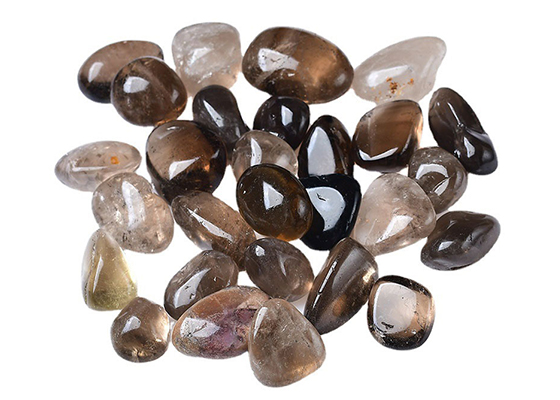As a gemstone enthusiast or someone who loves collecting crystals, you might have come across cloudy quartz and smoky quartz. At first glance, they might look similar, but there are some distinct differences that set them apart. In this blog post, we will explore the characteristics, properties, and uses of cloudy quartz and smoky quartz. Luxury jewelry wholesalers will guide you how to tell them apart and why it’s important to understand the differences between them.
What is Cloudy Quartz?
Cloudy quartz, also known as milky quartz or white quartz, is a variety of quartz with a white or grayish-white color. It gets its name from its cloudy or opaque appearance, which is caused by tiny fluid inclusions that scatter light. These inclusions can also give cloudy quartz a silky or waxy luster.
Cloudy quartz is a very common mineral and can be found all over the world. It is often used in jewelry and decorative items, as well as in industrial applications. Some of the characteristics and properties of cloudy quartz include:
- Hardness: 7 on the Mohs scale
- Density: 2.65 g/cm³
- Crystal system: Trigonal
- Refractive index: 1.544 – 1.553
- Cleavage: None
- Transparency: Opaque to translucent
Examples of cloudy quartz include tumbled stones, crystal clusters, and points. It is also commonly used as a material for carvings, such as figurines and vases.
What is Smoky Quartz?
Smoky quartz is a brown or grayish-brown variety of quartz that gets its color from exposure to natural radiation. The color can range from pale to dark, depending on the intensity of the radiation. It can also be found in shades of yellow, green, or black.
Smoky quartz is also a common mineral and can be found in many parts of the world. It is often used in jewelry and decorative items, as well as in healing practices. Some of the characteristics and properties of smoky quartz include:
- Hardness: 7 on the Mohs scale
- Density: 2.65 g/cm³
- Crystal system: Trigonal
- Refractive index: 1.544 – 1.553
- Cleavage: None
- Transparency: Transparent to translucent
Examples of smoky quartz include faceted gemstones, polished spheres, and raw crystals. It is also commonly used in meditation and energy healing practices.
Differences between Cloudy Quartz and Smoky Quartz
Although both cloudy quartz and smoky quartz are varieties of quartz, there are some distinct differences between them. Some of the main differences include:
Color and Transparency
Cloudy quartz is typically white or grayish-white and is opaque to translucent, while smoky quartz is brown or grayish-brown and is transparent to translucent. Cloudy quartz gets its color from tiny fluid inclusions that scatter light, while smoky quartz gets its color from exposure to natural radiation.
Formation and Origin
Cloudy quartz is formed in many different types of rocks, such as granite, pegmatite, and metamorphic rocks. It is often found in association with other minerals, such as feldspar, mica, and tourmaline. Smoky quartz is formed in a similar way but is exposed to natural radiation during its formation, which gives it its brown color. It is often found in association with other minerals, such as fluorite, calcite, and galena.
Uses and Applications
Cloudy quartz is commonly used in jewelry, decorative items, and industrial applications, such as in the production of glass and ceramics. It is also used in carvings and figurines. Smoky quartz, on the other hand, is commonly used in jewelry, meditation, and energy healing practices. It is believed to have grounding and protective properties, as well as the ability to transmute negative energy.
How to Tell Cloudy Quartz and Smoky Quartz Apart
While cloudy quartz and smoky quartz share some similarities, there are some visual and physical differences that can help you tell them apart. Here are some ways to distinguish between the two:
Visual Differences
- Color: Cloudy quartz is white or grayish-white, while smoky quartz is brown or grayish-brown.
- Transparency: Cloudy quartz is opaque to translucent, while smoky quartz is transparent to translucent.
- Luster: Cloudy quartz has a silky or waxy luster, while smoky quartz has a vitreous (glassy) luster.
- Inclusions: Cloudy quartz has tiny fluid inclusions that scatter light, while smoky quartz may have needle-like inclusions that are visible under magnification.
Physical and Chemical Properties
- Hardness: Both cloudy quartz and smoky quartz have a hardness of 7 on the Mohs scale.
- Density: Both cloudy quartz and smoky quartz have a density of 2.65 g/cm³.
- Refractive index: Both cloudy quartz and smoky quartz have a refractive index of 1.544 – 1.553.
- Cleavage: Neither cloudy quartz nor smoky quartz have any cleavage.
Conclusion
Cloudy quartz and smoky quartz are both fascinating varieties of quartz with their own unique characteristics and properties. While cloudy quartz is white or grayish-white and opaque to translucent, smoky quartz is brown or grayish-brown and transparent to translucent. Cloudy quartz is often used in jewelry, decorative items, and industrial applications, while smoky quartz is commonly used in jewelry, meditation, and energy healing practices. By understanding the differences between these two varieties of quartz, you can better appreciate their beauty and use them in a variety of ways.




